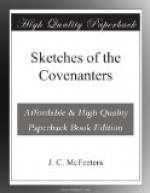King Charles’ war flurry against the Covenanters, in 1639, brought him no honor. Out-matched on the field, outdone in diplomacy, and utterly defeated in his purpose, he returned to London greatly humiliated. The journey was long and dreary, even though he rode in his stately carriage and behind swiftest horses, for he was chafing over his failure to reduce the Covenanters. In his palace also he found no comfort, his magnificent apartments brought him no restfulness. He brooded over his ill-fortune till his blood was tinctured with acid and his heart soured; a malignant spirit spread its dark wings over him. He had failed in his military operations; the Covenanters were stronger and more independent than hitherto; his Prelatic friends were aggrieved with his treaty of peace; his power to tyrannize over the public conscience was waning. Such thoughts racked his brain and wrecked his peace of mind. He grew sullen, miserable, desperate. It was this passionate and despotic temperament that carried him into the second war with these Covenanters whom he so thoroughly hated.
The Covenanters were yet truly loyal to their king. Their loyalty was high-principled and self-sacrificing, yet at the same time discriminating. They bound themselves by their Covenant to be true to their king and their country. The Covenant recognized the king and the people to be equally under the law of God, subjects of the moral government of Jesus Christ. While he occupied his rightful place and exercised legitimate power, they would stand by him till their blood and treasures were alike exhausted. Such was their oath of loyalty, and it was kept with sacred care. But they resisted his authority at the point where he attempted to crush conscience, rule the Church, and usurp the royal prerogatives of the Lord Jesus Christ, who is king of kings. There they drew the line, and drew it so clear, that all the world might see it, and the blindest king might pause, consider, and not pass beyond. There they uttered their solemn protest with the Bible in one hand and the sword in the other. Such encroachments on their rights and liberties, and upon the honor and supremacy of Jesus Christ, they met on the battlefield, when peaceful measures had failed. While these interests were at stake they counted not their lives dear.
[Illustration: The martyrs’ monument, Edinburgh.
This monument honors the memory of the martyrs who were executed at the Grass Market. It stands in Greyfriars’ churchyard at the head of a small plot of ground, where about 100 bodies were at sundry times heaped together. Here lies the dust of Argyle, Guthrie, Warriston, Cargill, Renwick, and others of equal fame and faithfulness in the Covenant.]
The king on this second occasion collected an army of 21,000 men—all he could then muster—and hastened to punish the Covenanters. He was not able at this time to rally the hosts of England; that kingdom was not in sympathy with his enterprise. His haughty will and arbitrary measures had alienated the strength of England from his support. The English Parliament was like a trembling volcano, ready to break out and involve his throne in ruins. A revolution from monarchy to democracy was sending its advance swell over the land like a tidal wave.




